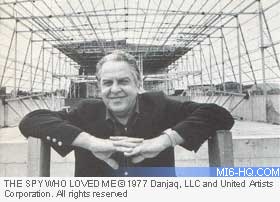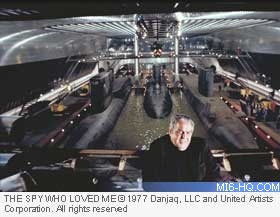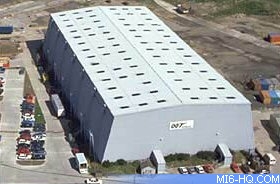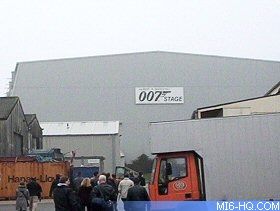 |
| |
Pinewood historian Gareth Owen gives his opinion on how the 007 stage at Pinewood helped save the British film industry...
|
|
Opinion - How the 007 Stage Helped Save the British Film Industry
2nd August 2006
HOW THE 007 STAGE HELPED SAVE THE BRITISH FILM INDUSTRY
OPINION BY GARETH OWEN
In 1976, during early pre-production for The Spy Who Loved Me
production designer Ken Adam faced a problem - finding a stage
big enough to house three nuclear submarines. Many locations were
scouted across the world, to no avail.
It seemed the only solution was to build a stage.
Producer Albert R Broccoli managed to persuade his backers
that they should extend the backlot reservoir at Pinewood
(which had previously been extended for Thunderball), to
then build a stage over it. The fact that it would be a
permanent structure and rented out to other filmmakers in
the future was the clinching factor, and a 50:50 future
revenue split deal was agreed between Rank (Pinewood's then
owners) and Eon.
Ken Adam and architect Michael Brown set to work, taking
seven months through the scorching summer of 1976 to construct
the '007 Stage' - measuring 334 ft by 136 ft by 40 ft 5
in, with an internal tank measuring 297 ft by 73 ft by 8
ft 10 in. It cost $1.65 million.
On December 5th 1976, it was officially opened by former
Prime Minister Harold Wilson, along with the films stars
Roger Moore and Barbara Bach. The 007 Stage forever changed
the skyline at Pinewood, and was rarely out of use afterwards.
Alas, tragedy struck on June 24th 1984, when during the
filming of Tom Cruise film Legend a lunchtime fire saw the
007 stage burn to the ground. How can a sheer steel structure
burn? Well, burn it did; as well as melt. Within hours,
the stage had gone.
|
|


Above: (top) Producer Albert R. Broccoli
during construction of the original 007 stage, and (bottom)
inside the huge tanker set.
|
The Bond team were already at Pinewood, preparing A View To A
Kill, and surveyed the molten mess. Production designer Peter
Lamont, along with Michael Brown, met Cubby Broccoli. They told
Cubby, given 13 weeks, they could rebuild the stage. Without flinching,
the legendary producer told them to go ahead.


Above: The 007 stage before the recent
fire. |
|
The design changed a little on the new stage, and it
became the most sophisticated and famous load bearing structure
in the film world. In January 1985, Roger Moore was on hand
to re-open and re-dedicate the stage the 'Albert R Broccoli
007 Stage'.
It has housed a set from virtually ever Bond film since,
including an impressive Venetian construction for the latest,
Casino Royale. Just prior to the 21st Bond film, the 007
Stage had also recently played host to two hugely successful
movies: the Louvre set in The Da Vinci Code and the wonderful
chocolate factory interior in Charlie And The Chocolate
Factory.
From its opening day the stage was not only the largest
stage in the world, it was the jewel in Pinewood's and the
British film industry's crown. During the business' leanest
time in the late 80s and early 90s, the stage helped lure
some of Hollywood's biggest blockbusters to film in the
UK - Batman, Interview With The Vampire, The Fifth Element,
The Saint, Event Horizon, First Knight, Mission: Impossible,
to name but a few. Pinewood survived. Other studios floundered.
In 2004 ownership of the stage reverted to Pinewood 100%
and bookings in the diary were healthy, not least with the
two Tomb Raider films having used the stage.
|
Disaster
In mid July this year, an impressive new sign was mounted on the
front of the stage, ahead of the studio's 70th Anniversary celebrations
in September, where it was to be re-dedicated by current Bond,
Daniel Craig. Sadly, on July 30th, tragedy struck once again just
after 11am when the alarm was sounded. The 007
stage was once again on fire.
Reaction was one of disbelief. How can it be on fire again? But
it was. Within minutes the emergency services were on site and
took 90 minutes to bring the blaze under control.
Monday 31st was a sad day at Pinewood. Our once proud 007 Stage
stood a blackened, folded wreck on the landscape. The heart of
Pinewood had been torn out. Investigations are still ongoing,
but it is thought gas cylinders being used by contractors dismantling
the Casino Royale set were to blame.
Within hours, Pinewood Shepperton plc moved to reassure its investors,
film-making friends and tenants that the jewel in its crown would
shine once again. The stage will be demolished and rebuilt.
There was little hesitation on the part of Pinewood's management
in making this announcement because quite simply they realise
the stage's importance. There is no other stage like the 007 anywhere
in the UK. The only one that comes close is H Stage at Shepperton
- a 70 year old structure transferred from Alexander Korda's Worton
Hall Studios in Isleworth. That is soon to be demolished under
a re-development plan.
It is imperative if Britain is to remain an international player
in big budget, big scale productions, that the 007 stage rises
phoenix like from the ashes to once again to dominate the Pinewood
lot.
As to whether Bond 22 will base at Pinewood, it would be foolish
to speculate before any official announcements are made about
the rumoured April 2007 start date. But the producers have always
been quick to describe Pinewood as the home of James Bond. He
travels often, but always returns...
About The Author
Gareth is co-author of "The Pinewood Story - The Authorised
History Of The World's Most Famous Studio", updated and expanded
softcover edition to be published in September 2006, by Reynolds
& Hearn.
The views of this columnist
and those expressed in this article are not necessarily those
of mi6-hq.com or its owners.
 Click here to submit your letters
to MI6
Click here to submit your letters
to MI6